Claude Amie Chenavard Paintings
Claude Amie Chenavard was a French painter born on October 31, 1798, in Lyons, France. He showed an early interest in the arts and was initially educated at the École des Beaux-Arts in Lyon before moving to Paris to further his studies. Chenavard's artistic journey was deeply influenced by the political and social upheavals of his time, including the French Revolution of 1789 and subsequent events that shaped France's cultural landscape.
Although not as widely recognized as some of his contemporaries, Chenavard was a part of the Romantic movement that dominated the early 19th century in Europe. His works were characterized by a tendency to include allegorical and historical subjects, which reflected the Romantic era's fascination with the past and the sublime. He was also known for his architectural paintings, which displayed a keen interest in perspective and the interplay of light and shadow.
Chenavard's career was marked by a commitment to conveying moral and philosophical messages through his art. This was particularly evident in his later works, which often sought to critique social injustices and advocate for political reform. Despite the idealistic intentions behind his paintings, Chenavard struggled to achieve the same level of fame and success as some of his peers. His works were sometimes criticized for their didactic nature and the perceived lack of emotional depth.
Tragically, Chenavard's life was cut short when he died at the age of 40 on November 12, 1838, in Paris. His death was a loss to the French art community, as it silenced a unique voice that was dedicated to blending artistic expression with social commentary. In the years following his death, Chenavard's contributions to the Romantic movement and French painting have been reassessed, and he is now recognized as an artist who was deeply engaged with the intellectual and political currents of his time.
